Introduction:
Augmented Reality (AR) and Virtual Reality (VR) are two emerging technologies that have revolutionized the way we interact with digital content and the physical world. AR overlays digital information in the real world, enhancing our perception and providing interactive experiences. On the other hand, VR immerses users in a computer-generated environment, simulating real-world experiences. Both AR and VR have found applications in various industries, including gaming, healthcare, education, and manufacturing, among others.
Embedded systems, on the other hand, play a crucial role in modern technological advancements. These are specialized computer systems designed to perform specific tasks within larger systems or products. Embedded systems are typically dedicated to a particular function and are tightly integrated into the overall system architecture. They can be found in everyday devices such as smartphones, cars, home appliances, and even industrial machinery.
Understanding Embedded Systems Design:
Embedded systems design involves the process of creating and developing embedded systems. It encompasses hardware design, software development, and system integration. The design considerations include factors such as performance, power consumption, size, cost, and realtime responsiveness. Embedded systems are designed to meet specific requirements, often with limitations on computational resources and memory. These systems must be reliable, efficient, and capable of interacting seamlessly with their environment.
Exploring Augmented Reality (AR) in Embedded Systems Design:
AR technology has transformed the way we perceive and interact with the world around us. By combining real-time computer graphics and sensor data, AR systems can enhance our sensory experiences and provide contextually relevant information. In embedded systems design, AR can be used to create wearable devices or smart glasses that overlay digital information onto the user’s field of view. For example, AR can be used in industrial settings to provide workers with real-time instructions, visual cues, and safety information, thereby improving efficiency and reducing errors.
AR in embedded systems also holds great potential in fields like healthcare. Surgeons can benefit from AR overlays during surgeries, providing them with vital patient information and real-time guidance. AR can also be used in training simulations, allowing medical students to practice procedures in a realistic virtual environment.
Leveraging Virtual Reality (VR) in Embedded Systems Design:
VR technology offers a fully immersive experience by creating a simulated environment that users can interact with. In embedded systems design, VR can be employed to create virtual prototypes of products, enabling designers to visualize and evaluate their concepts before physical production. This saves time and resources, leading to faster and more efficient product development cycles.
VR can also be utilized in training scenarios, allowing users to practice complex tasks in a safe and controlled virtual environment. For example, pilots can undergo simulated flight training, surgeons can practice procedures, and industrial workers can learn how to operate machinery in a risk-free setting. By leveraging VR in embedded systems, training programs can become more accessible, cost-effective, and tailored to individual needs.
Challenges and Considerations in AR and VR Embedded Systems Design:
Despite the promising potential of AR and VR in embedded systems design, several challenges need to be addressed. Firstly, there is a need for powerful hardware and efficient software algorithms to handle the real-time processing and rendering demands of AR and VR applications. This requires careful optimization to ensure a seamless and immersive user experience.
Another challenge is the integration of various sensors and technologies within embedded systems. AR and VR systems rely on accurate tracking, depth sensing, and gesture recognition capabilities to deliver precise and interactive experiences. The seamless integration of these technologies into compact and power-efficient embedded systems poses significant engineering challenges.
Moreover, the design of AR and VR systems must consider factors such as user comfort, ergonomics, and safety. Wearable devices should be lightweight, comfortable to wear for extended periods, and not cause discomfort or motion sickness for users.
Future Prospects and Trends:
The future of embedded systems design lies in the continued advancement of AR and VR technologies. As hardware becomes more powerful and miniaturized, we can expect embedded systems to offer more immersive and realistic experiences. The integration of artificial intelligence and machine learning algorithms will further enhance the capabilities of AR and VR systems, allowing them to adapt and respond intelligently to user interactions and their environment. In addition, the emergence of 5G networks will enable faster and more reliable data transfer, facilitating real-time collaboration and interaction in AR and VR environments. This opens up possibilities for remote training, telemedicine, and virtual meetings with realistic avatars. Conclusion: Augmented Reality and Virtual Reality have the potential to transform embedded systems design and revolutionize the way we interact with technology. By incorporating AR and VR into embedded systems, we can create more intuitive, immersive, and efficient experiences in various industries. However, to fully realize this potential, we must overcome the challenges associated with hardware limitations, sensor integration, and user comfort. As technology continues to evolve, the future prospects for AR and VR in embedded systems design are exciting, promising a new era of interaction and innovation.





